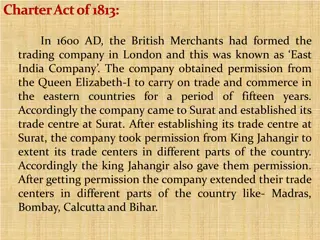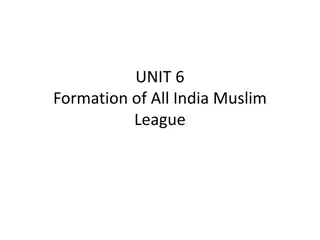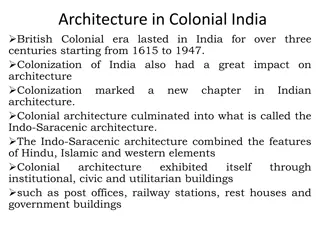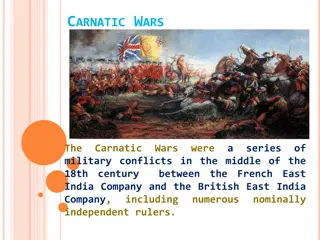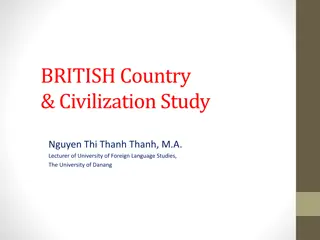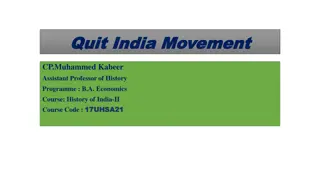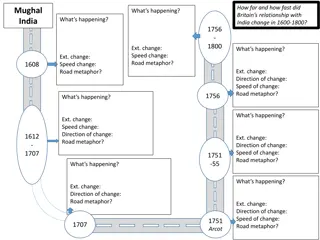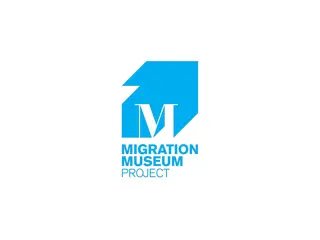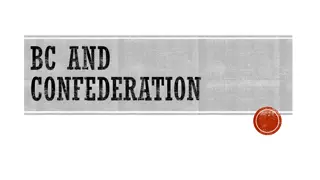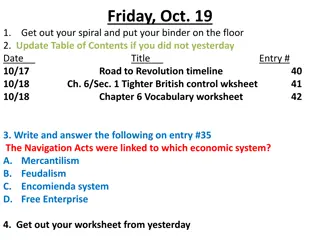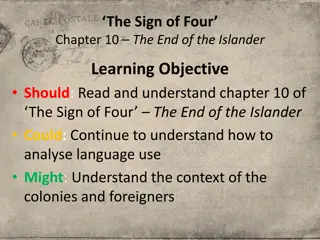British Administration in India: 1639-1726 Development
Development of British administration in India from 1639 to 1726 under the British East India Company, including the formation, charter, legislative powers, judicial system, and establishment of trading centers like Surat. The administration of justice and court developments during this period are highlighted, showcasing the early stages of British rule in India.
Download Presentation

Please find below an Image/Link to download the presentation.
The content on the website is provided AS IS for your information and personal use only. It may not be sold, licensed, or shared on other websites without obtaining consent from the author. Download presentation by click this link. If you encounter any issues during the download, it is possible that the publisher has removed the file from their server.
E N D
Presentation Transcript
MODULE II DEVELOPMENT OF ADMINISTRATION BY THE BRITISH IN INDIA (PERIOD 1639-1726)
Charter British East India Company. Constitution=Governor+25 Directors elected for every year. Tenure = 15 years but power to revoke charter Crown after giving years. of 1600= Formation of was with notice British of 2
Limited legislative powers given. Charter of 1609 monopoly of EIC made perpetual but company s terminated with company involves in something which is against the interest Government. Royal Grants of 1615 grant allows company to direct each voyage commander to punish employee for capital offence punishment. could notice be if 3 years of the British & 1623=1615 with the capital
Grant of 1623 allows the company to inflict with capital punishment for servants doing capital offences in land also. Grant of 1615 strengthen the position of EIC in India. and 1623 had
In early days the administration of justice in the settlement East India Company was not a high order. There was no separation between the executive and the judiciary was under the control of the executive the judges were not a law expert. The company gave lesser importance to the judicial justice and rule of law. judiciary the independence fair
The administration of justice and developments of courts and judicial institution during this period may discussed under headings 1600 to 1726 is the first period. 1726 to 1773 is the second period. Administration development of Company (presidency town). the following of justice East and India
Surat commercial trading centre by EIC as International port was situated there. The Portuguese were in occupation of the place. The clash of 1612 Britisher's & Portuguese ousted the later. Accordingly the first factory of ESI was established in Surat. was the identified as between the
The factory was within the Mughal empire so they are to take permission from them to carry on the trade and business. In 1615 EIC (Sir successful to get from the Mughal king & few of them are: i. Englishmen are Indian territory according to their own laws and religion. ii. Dispute between the Englishmen is allowed to settled inter-se. Thomas) some was concession allow to live in
iii. Dispute between the Englishmen and natives is to be settled by the local laws. iv. Kazi is under safeguard the Englishmen. the duty of to interest the
British Settlement of Madras & Administration of Justice In 1639 Francis Day acquire a piece of land from a Hindu Raja for the East India Company and constructed a factory. The area of the factory came to be known as while town mostly Englishmen were residing there. The people residing in the village Madras- Patnam were mostly Indians and therefore it came to be known as Black Town. The Whole Settlement Consisting of white town and black town came to be known as Madras The administration of developed in three stages. justice in Madras
STAGE I 1639-1678 STAGE II 1678-1683 STAGE III 1683-1726
Stage I Land establishment of factory from Hindu King in 1639. EIC constructed Fort St. George in 1640 which was known as white town. Nearby villages of local people was known as Black Town. White town & Black town was Madras. White town agent empowered to decide the civil and criminal cases. was acquired in Madras for and council were
Choultry Courts were functioning to decide the petty disputes by the native judges called Adhikari. Charter of 1661 empowered EIC to appoint Governor and Council who are to decided civil and criminal cases of all persons of company.
SATGE II Later administration was re-organized. High Court of Judicature established who sat twice in week and try civil and criminal cases with help of jury and also hear appeals from Choultry Courts. Old Choultry courts were reconstructed. Adhhikari was replaced officers. They sat twice in week and tried civil cases within 50 pagodas, appeal lies to Governor and Council. on, 1678 the whole judicial by the English
STAGE III Admiralty Court was established in 1686 headed by Judge Advocate. This court consisting of 3 people one who knows civil laws and tw0 merchants. This court dealt with cases of maritime, mercantile, trespass, injuries in high seas, forfeiture and seizure ships and goods. Rules of equity, good conscience and laws and customs and the court dealt with all civil and criminal cases of city till 1704.
MAYORS COURT In the year 1687 Company established Madras Corporation and Mayor s Court was the part of this corporation. Court consisting of Aldermen. Mayor hold office for one year. Aldermen elected Mayor annually. 1 Mayor and 12
British Settlement of Bombay & Administration of Justice Bombay was under Portuguese in 1534. Portuguese give it ad dowry to King Charles II. (Married to Portuguese king s sister) Charles II could exercise power from England therefore he transferred it to EIC on annual rent by Charter of 1668.
Administration of Justice in Bombay PHASE I (1668-1683) PHASE II (1684-1690) PHASE III (1718-1726)
PHASE I (1668-1683) Charter of 1668 Empowers ordinances Bombay and also to exercise judicial control through its governor and officers . Initially it was under control of President and Council of Surat and the Governor of Surat was Ex-Officio Governor of Bombay. It was in 1669 Deputy Governor and Council was given control of BOMBAY. EIC to to form administration laws and in for
JUDICIAL REFORMS OF 1670 Portuguese Laws and Customs were allowed to continue the Island of Bombay. It was divided into two divisions. One division consisted of Bombay, Mazgaon and Girgaon. The other comprised of Mahim, Parel, Sion and Worli. Court of judicature was established for each division at Bombay and Mahim. Each court consisted of Five Judges. Three judges formed the quorum of the court
Court of cases of small thefts and all civil actions up to 150/-. Appeal against the judgment lies to court of Deputy Governor and Council. Judicature could determines
NEW JUDICIAL PLAN OF 1672- Portuguese laws was abolished. Court of Judicature was established in two division (BOMBAY & MAHIM) Jurisdiction over all Civil a and Criminal and Testamentary cases JUSTICE OF PEACE (Administration of Criminal Justice System) (Bombay, Mahim, Mazagaon and Sion) Court of Conscience to decide petty civil cases.





